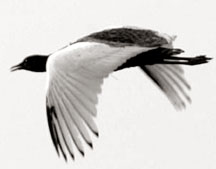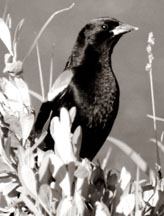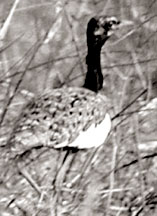|
observer |
|
|
|
|
|
OTHER LINKS |

|

|

|
Fifth of world's bird species in danger of extinctionIncluding Lanka's Serenade Owl
Janos Olah BirdLife International's annual evaluation of how the world's bird species are faring shows that the total number considered threatened with extinction is now 1,210. When combined with the number of near threatened species this gives a total of 2,005 species in trouble - more than a fifth of the planet's 9,799 total species. The Bengal Florican Houbaropsis bengalensis, a globally endangered species of bustard is rapidly losing its grassland habitat within the inundation zone of the Tonle Sap Lake in Cambodia. Not only could the Florican become locally extinct, but the whole suite of species dependent on these grasslands could be lost. Local communities who have been dependent on these grasslands for their livelihoods are joining with BirdLife, Wildlife Conservation Society and local government to find a solution. In Vietnam the species is already believed to be extinct as a result of grassland conversion.
Not all species that are faring badly are found in the tropics. The black-tailed godwit, Limosa limosa, a migratory wading bird whose breeding population is concentrated in Europe, has declined in number by around 25 per cent over the last 15 years. As a result, the species is now classified as globally near threatened. Loss of nesting habitat owing to wetland drainage and agricultural intensification are its biggest threats. In North America, the tricoloured blackbird Agelaius tricolor breeds only in California. Its numbers have fallen from more than 700,000 birds in the 1930s to just over 250,000 in 2005. The speed and extent of this decline means it is now classified as endangered, the second highest risk category. "Loss of upland nesting sites combined with low reproductive success in native habitats and complete breeding failure in harvested agricultural fields are the most likely causes of the tricoloured blackbird's worrying decline," commented Dr Stuart Butchart, BirdLife's Global Species Programme co-ordinator. Of the species most at risk, 181 are now categorised as critically endangered, the highest level of threat. New additions include the purple-backed sunbeam Aglaeactis aliciae, a hummingbird found only in a tiny 1sq.km area of alder woodland in western Peru.Recently, much of this crucial habitat has been replaced with eucalyptus, which will have a devastating effect on a species already numbering fewer than a thousand individuals. Another species now regarded as critically endangered is the uluguru bush-shrike, Malaconotus alius, from the Uluguru Mountains of Tanzania. Repeated surveys in the 1990s found that the species is restricted to the small Uluguru North Forest Reserve, which is suffering from ongoing habitat degradation. Loveridge's Sunbird Nectarinia loveridgei, also, only found in the Ulugurus, has also been uplisted (to endangered) to reflect its continuing decline. However, it is not all bad news: the seychelles fody Foudia sechellarum, a small yellowish songbird has been down listed to near- threatened. Habitat management and conservation measures have encouraged the regeneration of natural woodland on its island homes and are thought to have been key factors in the recent substantial population increase. Nature Seychelles (BirdLife in the Seychelles) has also recently translocated birds to Denis and Aride islands where self-sustaining populations are now established. "This is a credit to the efforts of Nature Seychelles and others who can now add this species to a significant list of native Seychelles birds that have been brought back from the brink of extinction," commented Dr Butchart. Several new species are also recognised in the 2006 update, including the serendib scops-owl Otus thilohoffmanni (endangered) from Sri Lanka. The long-legged thicketbird Trichocichla rufa is also evaluated for the first time as Endangered, following its rediscovery in 2002 on Fiji. However, a warning as to the ultimate fate that could await some of these species is offered by a number of extinct species that appear on the list, for the first time. These include three species of monarchs (small songbirds) from French Polynesia that had already disappeared before taxonomic studies recognised them as full species - in one case (Ua Pou Monarch) as recently as 1985. "We face a huge challenge in improving the status of the 1,210 threatened and 795 near threatened species. But the success stories show that concerted conservation action can save these birds from extinction: we just need the political will and resources," added Butchart. VNS |










